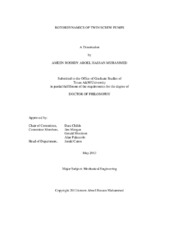| dc.description.abstract | Twin-screw pumps are positive displacement machines. Two meshing screws connected by timing gears convey the fluid trapped in the screw chambers axially from suction to discharge and force it out against the back pressure. Because of the screw geometry, the circumferential pressure field around the screws is not balanced, resulting in net dynamic and static pressures applied on the rotors. The research work presented here aims at building and verifying a model to predict both: (1) the exciting lateral hydrodynamic forces produced by the unbalanced pressure field, and (2) the rotor response due to those forces. The model rests on the screw pump hydraulic models for predicting the pressure in the screw chambers as a function of the discharge pressure. These models are extended to predict the steady state dynamic pressure field as a function of the rotational angle of the rotor. The dynamic force resulting from the dynamic pressure field is calculated and applied to the rotor as a set of super-synchronous periodic forces. The structural model of the screw, although nonsymmetrical, was found to be accurately represented by an axisymmetric equivalent structure. The rotor response to the dynamic super-synchronous forces is calculated to predict the pump rotordynamic behavior.
The work in this dissertation presents: (1) the axisymmetric structural model of the rotors (2) the proposed dynamic pressure model, (3) the screw pump rotor response, (4) the experimental validation of the dynamic pressure model and rotor response.
The topic of twin-screw pump rotordynamics is absent from the literature. The original contribution of the work presented in this dissertation to the field of rotordynamics includes: (1) demonstrating the adequacy of an axisymmetric model for modeling the screw section, (2) developing a model for predicting the dynamic pressure field around the screws, (3) characterization of the dynamic forces (synchronous and its harmonics) applied at the screw pump rotors, (4) predicting the dynamic response of twin-screw pump rotors due to hydrodynamic forces, (5) measuring the axial dynamic pressure in two circumferential planes around the screws to verify pressure predictions, (6) measuring the dynamic response of twin-screw pump rotor. | en |


